- Posted on
- Unique Submission Team
Performance measurement system
I DhanrajSolanki Banner ID B00316803, hereby declare that this project specification report entitled
Investigation on the effect of manufacturing strategy and total productive maintenance on manufacturing performance.
Submitted by me to the University of The West of Scotland in partial fulfilment of the requirement for the award of the degree of MSc. Engineering Management is my own work under the general supervision of my supervisor Dr FarhadAnvari.
The guidelines provided by the University on plagiarism and cheating have been followed in writing the project specification report.
Signed: DHANRAJ SOLANKI Date: 20th April 2018
In this research proposal, the identification of appropriate strategy for SME business in UK is covered. This involves investigation of mission and goals of organisation, consideration of metrics, implementation of performance measurement system in the organisation for attaining business objectives.
The researcher has performed detailed study of literature for deciding survey strategy as method of research for collecting data. Data has been analysed for generating information and completing objective of research.
The complete research has been divided into different chapters for arranging activities in proper sequence. Finally, all findings will be submitted to sponsoring organisation along with recommendations after completion of the research study.
The objective of the study is to devise a PMS i.e. Performance Management System which would support the structure of organisation for SME (small and medium enterprises). The SME selected is located at western part of Scotland, in sector of automotive manufacturing and is supplier of category Tier 2.
This assignment will provide a framework of documents regarding implementation of framework for providing each department its separate and clear goal which is in line with the organisation’s goal.
Enactment of important metrics based on the orientation of performance as well as strategies will make sure that organisation sustains its focus even in constant changing business environment.
- To understand the strategies of firm by consulting with higher officials of the organisation and identify sectors which requires improvement by performing SWOT (Strength, weaknesses, Opportunities and threats) analysis.
- To analyse the prevailing PMS in industry and assess its utility by performing a research on manufacturing industries of UK and Scottish SMEs.
- To evaluate the important performance indicators (metrics) used in manufacturing firms and provide an appropriate metrics on the basis of above survey, review of literature as well as guidelines of local authorities.
- To analyse and identify any barriers in the path of implementation and assessment of organisational culture for selecting cost effective method of implementing change management.
- To generate a formal document which could be provided to all concerned for implementing the change.
The literature clarifies that, in the prevailing market conditions organisations are required to constantly improve quality of service, enhance customer satisfaction by bringing more flexibility, reduction in lead time, develops of products with the aid of technology (Stone, 2014).
The literature contains various articles in relation to Performance Measurement System but there is hardly any article with focus on its implementation in SMEs, mainly in UK. This provides scope for performing this study.
Availability of Industrial Sponsorship
A large portion of the research will be covered by the organisation for which I am presently working. Apart from that, the organisation is also offering me sponsorship for performing this research as this would prove advantageous to the company as it has faced tough times in recent past.
Based on this, organisation has vested interest in the project and has assured all kind of support for the study and shown interest in implementing valuable recommendation based on the study. Moreover, the research would also contribute to development of career in the organisation and increase my level of skills.
To avail the membership of IET (Institute of Engineering & Technology) there are certain requirements. Registration of professionals with council of engineering requires demonstration of commitment and competence, as mentioned in documents of UK-SPEC.
UK-SPEC ( United Kingdom Standard for Professional Engineering Competence has clearly laid down requirements regarding commitment and competency which must be met before applying for registration as EngTech ( Engineering Technician), CEng ( Chartered Engineer ) r IEng ( Incorporated Engineer).
The 5 categories required to be fulfilled for this are mentioned below-
- Understanding and Knowledge
- Designing as well as process development including development of services, systems, and products
- Management Leadership and Responsibility
- Inter personal and Communication skills
- High level of Professional commitment
The project has large scope for demonstrating all these competencies for gaining membership as IEng i.e. Incorporate Engineer which could later be advanced to CEng i.e. Chartered Engineer.
During the year 2016, I was with the organisation and have worked in different department like engineering department and commercial department. Though, the nature of my role in both the department was same i.e. wining business for the organisation. This assignment would help me in understanding the functionality of the organisation as well as functionality common in the industry.
There are number of experienced faculties available in the campus of UWS Hamilton in the stream for engineering as well as manufacturing. I expect that for this study the allotted supervisor will be DR FarhadAnvari, who is having more than twenty years of experience in industrial world and around sixteen years of experience of delivering lecture in British and other International Universities.
In the past he has been supervisor of numerous students of post-graduation and overseen seven thesis f PHD and fifteen dissertations of MSC students. Dr Anvari is also a professional writer with own publication of around twenty articles and published eight books related to Engineering and management subjects.
The Requirement for improvement and performance measurement
In the view of Heathfield (2015), in the present competitive market, organizations are facing huge competition in operating business. In order to make business successful there is requirement to ensure satisfaction of consumers with high quality product maintaining lessen costs and flexibility.
It is a continue process which must be resulted in improvement in product and process (Tschiesche, 2018).
There are several authors who are not agreed on one definition of performance management. Common definitions on performance management are:
“Performance evaluation system is like a set of metrics which is helpful in quantifying effectiveness as well as efficiency of actions”- Clardy (2013)
“Performance management is evaluation of organization that is how an organization is managing well and how well they are delivering values to stakeholders and customers” (Aguinis, 2012)
Performance Measurement Systems
In the view of Axson (2010), PMS i.e. Performance Measurement Systems has shown two trends since its origin in 1880s. In earlier period it is done on the basis of financial outcomes and later looked in a balanced view, under which company is evaluated at different levels apart from sales perspective.
As per (Blizzard, 2014), Various academicians have realised that first trend was inadequate in incorporating changing requirements of economy, which has resulted in emergence of second trend which has produced advanced PMS like Balance Scorecard, Business Excellence model.
In late 1980s to early 90s PMS gets huge popularity which has provided attractive earning by way of consultancy, software, marketing etc. (Bremser and Wagner, 2013).
This report assesses the framework and techniques along with uncovering of weaknesses, strength and reasons behind failure and promotion of methods for resolving problems. For instance, Balance score card has been criticised by the critics on the ground that it shows persuasive language of outcome but hardly provides concrete facts.
Much literature published in relation to PMS in past 10 years which explained the ways of development of models, under which BSC was the oldest one while Business Excellence model is viewed as more connected with today’s business requirements, as in initial period PMS applied for firms which used to be tailored mainly as per the goals of the organisation.
Also, because of availability of literature in large volume, there was hardly any commonly accepted d framework (Buckingham and Goodall, 2015).
However, literature explains that various tools have been developed for assisting in implementation of PMS like use of questionnaire for assessing the performance of prevailing PMS and changes required.
The tools must assist the company in measuring balanced performance; confirm that philosophies, strategies are consistent and comprehensive (Dekker, Ding and Groot, 2016).

Figure 1: Neely’s Performance Measurement Record Sheet
Successful implementation of PMS requires constant and regular monitoring to make it more viable. The literature also provided details of various barriers in the path of success and the cause of failure sin eth history of PMS. The below figure provides illustration of causes of failures and barriers to success.
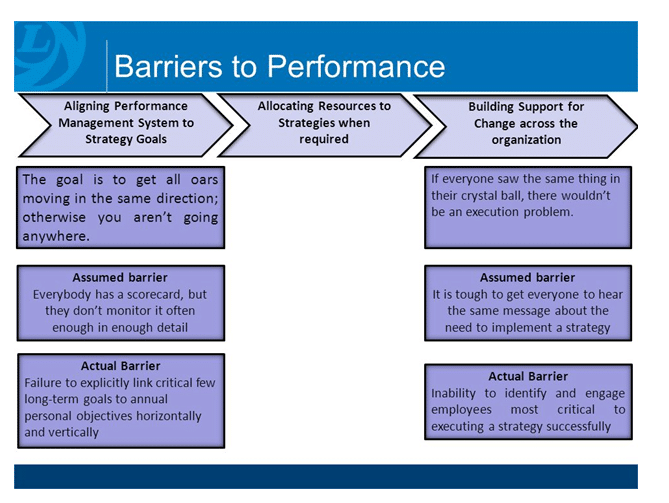
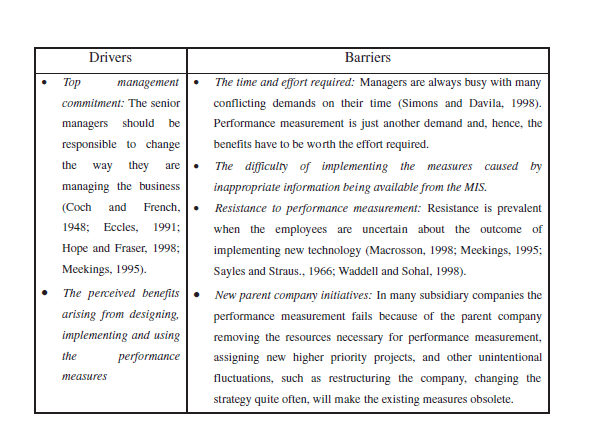
Figure: Drivers and barriers to implementation of PMS.
Source: Ditillo (2016)
It is mentioned in literature that no study has been performed on implementation of PMS in SMEs, however, certain related case studies presented in the literature, which requires detailed study, particularly in context of UK.
A study was noted 10 years back regarding Balance Scorecard implementation in Biddle Air Systems, which is expert in air curtain and climate control technologies, having production plant in UK and office in Germany, Belgium and France, but there are all chances that study has no relevance with the present business conditions and present barriers in implementation of PMS.
In the view of Faupel (2012), for achieving success in business, companies are required to have well denied business objective as well as sound strategies for attaining these objectives i.e. what is to be achieved and how to achieve that. The below figure provides the association between different functions of organisation under PMS.
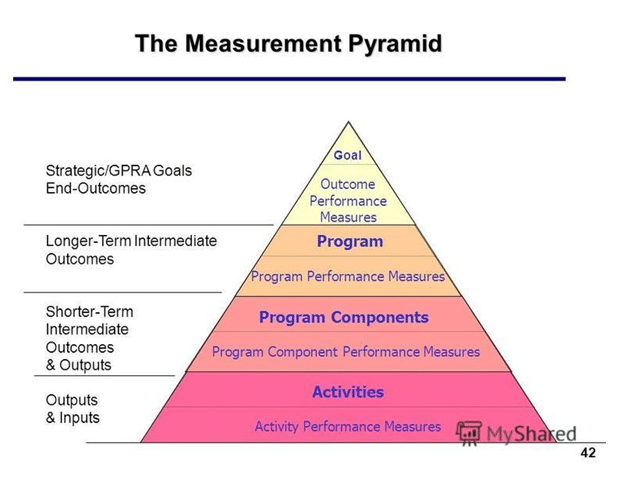
Figure: Performance Measurement Pyramid
Source:Fine (2012)
Techniques and tools for measuring effectiveness of strategies of companies are present in literature. One such technique is SWOT analysis which helps in knowing strengths and weaknesses of the company and opportunities and threats available to the business.
Use of brainstorming technique has been considered very effective involving consideration of all stakeholders.
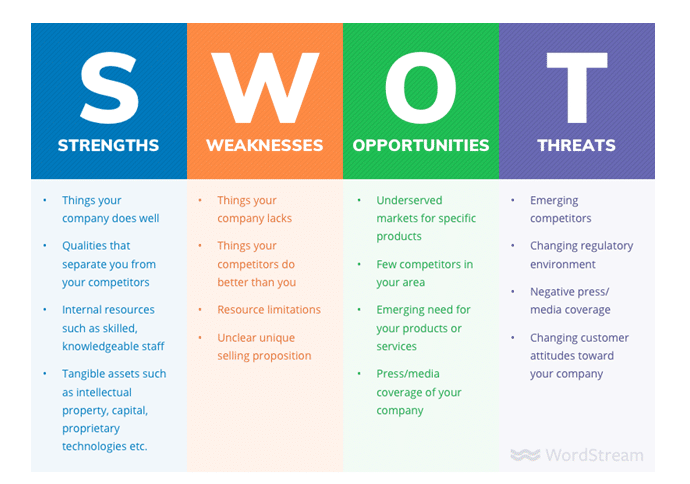
In the view of Hofmann, N., R. L. Insner and F. Poschadel (2017), another popular tool is benchmarking, which provides a comparison of set standards with original results to reflect the issues requiring attention. As per Kokina, Pachamanova and Corbett (2017), Benchmarking also involves consideration of targets of competitors for providing effective outcome.
As per a report on implementation of benchmarking framework in SME , SMEs are required to utilise benchmarking technique with tangible and accurate measures like percentage of rework, percentage of rejection, level of work in progress, lead time tec (Lau and Scully, 2015).
Balance score card is a model to measure performance. Balance score card performance measurement model is developed by David Norton and Robert Kaplan. In the view of Kalpan and Norton (2000), main objective of the Balance score card performance measurement model is for translating vision as well as mission into operational and actual actions i.e. strategic planning.
in the view of Poschadel (2017), Balance score card performance model helps in offering information with respect to selected strategy more, learning processes, managing feedback and in defining the focused figures. Through it measurement of actual actions can be done and it results in adjusting as well as understanding the selected tactics.
Balanced Scorecard implementation
There are particular numbers of stages which have to cover in order to implement Balance score card performance model. Setting upvision, strategy and mission by top level management is the first step.
Strategic objectives are the base in order to develop strategies, vision and mission for the organization. Second step is giving information about objectives of vision, mission and strategy to middle level management (Poschadel, 2017). Managers are also invited to discuss their opinion and express their views with respect to these strategic objectives which indicate their involvement in achieving organizational objectives and critical success factors.
There can be survey or interview in order to know expectations of each and every one about Balance score card performance model of particular organization. This will lead to accomplish objectives of the organization (Fine, 2012).
Broadly, Balance score card performance model can have following steps:
- Setting up strategic objectives, vision and mission
- Conduct an analysis of stakeholder in order to find out expectations of stockholders as well as customers.
- Make a list of critical success factor of the organization in respective industry
- Transformation: personal goals from strategic objectives
- Create key performance indicators in order to evaluate the objectives which have set earlier
- Define important values to the objectives and goals which are going to be achieved.
- Translate the objectives into operational tasks
In the view ofPoschadel (2017), accomplishment of strategic objectives is a process which is continues in nature. It can be said as PDCA (plan-do-check-act).
Key Performance indicators and Critical Success Factors
In the view of Paladino (2011), critical success factors can be seen as description of crucial requirements for the organisation which required must be present in organisation to be successful.
And when such elements are combined with KPI (Key Performance Indicators) then it provides concrete figures to achieve (Sharman, 2016). It makes each objective measurable and thus makes it manageable. The below figure illustrates such relationship.
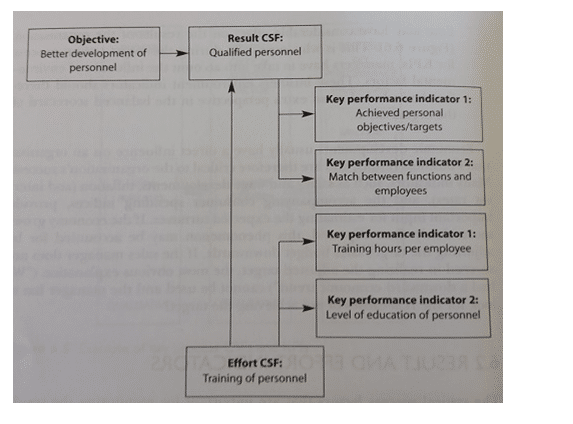
Figure: Example of Objective-CSF-KPI relationship (Sharman, 2016)
Industries often publish KPI related to their industry which assists companies in deciding their strategies (Sharman, Hatch and Stoehr, 2015). Government also publishes KPI for providing guidance to industries. Figure 6 reflects various KPI important to the process of manufacturing.
The list might be used as a point of commencement, although further verification is required for discovering the applicable KPI for the SME industries of UK.
The literature describes certain standard KPIs which are specific to industries and mostly found in all big organisations belonging to same industry. In the view of Stone (2014), apart from that certain KPI at strategic level are common to all industries like construction, healthcare, banking, FMCG, some examples includes revenues, satisfaction level of customers, employee turnover, customer retention etc.
The literature reflects that, the main reason behind failure in implementing Performance measurement system and Key performance indicator is selection of incorrect metrics (Tschiesche, 2018). As per Heathfield (2015), it means that metrics is not suited with the strategies of the organisation and might also be based on incorrect or unreasonable data etc.
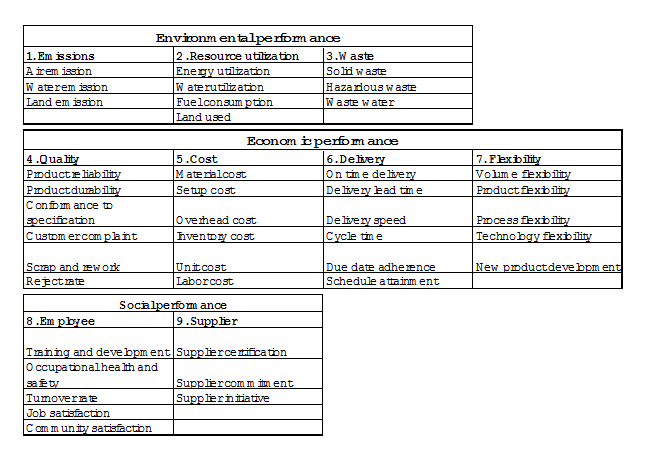
Figure: KPIs most referenced in literature
Support of Government agencies
In the view of Clardy (2013), government is committed about well-being of SMEs, and for the successful implementation of such programs there are various schemes offered by government to make available required resources as well as expert’s advice to SMEs.
The DTI (Department of Trade and Industry) of UK has established a KTP i.e. Knowledge Transfer Partnership centres. The KTPs acts as linkage between learning institutions and companies and appoints graduates to educate organisations regarding new skills and knowledge (Blizzard, 2014).
Similarly, in Scotland, government has set up SMAS (Scottish Manufacturing Advisory Service) which provides experts’ advice to companies of Scotland who obtain membership of SMAS and assisting in implementation of development projects based on consultancy services (Bremser and Wagner, 2013).
Survey and Case Studies Design
For performing the any primary research, there is requirement of contacts within industry and this might be helpful in using different research methods for collection of data. While collected data regarding KPI and PMS in companies survey method would be effective.
Buckingham and Goodall (2015) used the survey method for analysing the impact of KPI in manufacturing industry by covering automotive industry of Malaysian.
The research involved testing of survey prior to its wide distribution to make necessary amendments based on the results of testing and later distribute the survey forms among different organisations selected for survey for getting required number of responses.
Similarly, Dekker, Ding and Groot (2016), uses questionnaire for collecting responses from employees in a manufacturing industry in Australia for making the research quantitative.
A study performed by Ditillo (2016), regarding implementation of balance score card method for a case study. The research explained as to how BSC was implemented, resources required for its implementation, problems faced during implementation and outcome from implementation. The conclusion provided the learning and acted as guide for further study.
The academic literature contains numerous advices in relation to designing of case studies and surveys. Surveys, questionnaire, codification are imports aspect of gathering data. It includes selection of appropriate questions which are interlinked with each other. As suggested by Faupel (2012), survey questions must not be overlapping as it might confuse the respondents. The message must be clear and easy to understand to get clear response.
The culture of the organisation must be such that necessary changes might get implemented without many problems. According to Fine (2012), if the organisational culture shows inability of accept change then it might be the main cause behind failure of implementation attempt of Performance measurement system within the organisation.
As per Hofmann, Insner and Poschadel (2017), Barriers in the path of successful implementation of PMS are-
- Involvement of huge investment and time in the process of collection of data, data analysis and reporting of information.
- Use of irreverent or out of date data leading to misleading information
- Attempting all changes in one go, which create chaos in the organisation.
- Resistance to change within the organisation.
- Low level of motivation of employee to accept changes and contribute to successful implementation.
There is vast literature available regarding bringing changes in the organisation and resolving resistance to change. Some of these are Lewin’s model of Actin Research, Force Field analysis, eight steps of managing change etc (Kokina, Pachamanova and Corbett, 2017).
A detailed review of literature assists in identifying gaps in previous researches, deciding objectives of the research; provide base for section of technique and tools for research. Literature containing previous researches, articles of scholars, journals which acts as guide for continuing the research in right direction.
In the case of SMEs, external assistance is provided by government. However, the company has already hired researcher for the analysis rather than taking assistance from DTI facility of KTP i.e. Knowledge Transfer Partnership. Company will also sponsor the research for getting valuable recommendations.
Government agencies will also be contacted for providing them copy of research proposal for more partnership in future.
The literature indicates that the effective implementation of PMS is a basic requirement for the success of the organisation. In the absence of clear mission and strategies, implementing changes is very difficult and might become the main reason behind failure in implementation. For that, the support must flow from top management.
SWOT analysis helps in setting benchmarks based on the weakness and strengths of company and activities of competitors, deciding appropriate technique and tools for implementing strategies. With the help of SMAS and other students, other companies will also be visited to understand their working.
To realise the full potential of research, meetings with managers is required for assessing quality and engineering services within the organisation as well as requirement of resources for performing different tasks. For analysing the requirement of customers, sales register and suggestions and complain book will be analysed.
For knowing the prevailing practices of KPIs and PMS in SMEs (part of 2nd and 3rd objective) a survey will be performed on different SMEs of UK. To appropriate present data codification system will be decided. A testing of survey method will be performed for confirming the replies of one question do not clashed with others.
The most appropriate research philosophy would be selected for the study and case studies will be performed on similar kind of SME organisation of Scotland for getting better understanding of problems during implementations.
For deciding appropriate PMS for studied organisation different requirements will be assessed. A matrix will be developed with due weightage for different requirements.
Based on the research, a KPI list will be prepared and linked with the related functional areas within the organisation.
The literature has helped in understanding the probable issues that might occur during implementing changes. For that, group sessions will be organised in which employees will come and explain their problems. The meeting would help in developing ways to overcome resistance at the time of implementation. This will also motivate employees to contribute their ideas for improvement in the organisation.
Development of an implementation document
The implementation document will be the end of the research work and would fulfil first four objectives. The literature made it clear that the popular tools for PMS are BEM and BSC. The document shall prescribe timeline for achieving each milestone of implementation process. Earlier case studies provide an idea of writing the document.
PRACTICAL and ETHICAL CONSIDERATIONS
The crucial ethical consideration in the research is regarding people taking part in the survey as the research must not affect their association with the organisation. For that, the identity of the participant will be kept secret with no need to provide name or any such detail.
The researcher will also take consideration of working hours of company and take prior approval before commencing survey. As the organisation is interested in the survey there would not be any problem in performing the survey during office hours which would make employees more comfortable as the survey is not killing their personal time.
The replies will also be stored properly for avoiding any physical damage.
The practical consideration involves collection of reasonable responses from both external as well as internal parties, participating in survey. In the absence of appropriate number of responses, biasness can be happened affecting the formation of inappropriate strategies causing loss to organisation.
References:
- Aguinis, H. 2012. Performance Management (3rd edition). Prentice Hall. (Human Resource emphasis).
- Axson, D. A. J. 2010. Best Practices in Planning and Performance Management: Radically Rethinking Management for a Volatile World, 3rd edition. Wiley.
- Blizzard, D. 2014. Effective performance management. Journal of Accountancy (July): 18.
- Bremser, W. G. and W. P. Wagner. 2013. Developing dashboards for performance management. The CPA Journal(July): 62-67.
- Buckingham, M. and A. Goodall. 2015. Reinventing performance management: How one company is rethinking peer feedback and the annual review, and trying to design a system to fule improvement. Harvard Business Review(April): 40-50.
- Clardy, A. (2013). A General Framework for Performance Management Systems: Structure, Design, and Analysis. Improv., 52(2), pp.5-15.
- Dekker, H. C., R. Ding and T. Groot. 2016. Collaborative performance management in interfirm relationships. Journal of Management Accounting Research28(3): 25-48.
- Ditillo, A. 2016. Discussion of Collaborative performance management in interfirm relationships. Journal of Management Accounting Research28(3): 49-54.
- Faupel, C. 2012. Value-based performance management. Advances in Management Accounting(20): 187-208.
- Fine, C. H. 2012. Clockspeed: Winning Industry Control in the Age of Temporary Advantage. ReadHowYouWant.
- Heathfield, S. (2015). Manage the Perfect Project.
- Hofmann, N., R. L. Insner and F. Poschadel. 2017. Revolution or evolution in business performance management? Cost Management(July/August): 7-19.
- Kokina, J., D. Pachamanova and A. Corbett. 2017. The role of data visualization and analytics in performance management: Guiding entrepreneurial growth decisions. Journal of Accounting Education (38): 50-62.
- Lau, C. M. and G. Scully. 2015. The roles of organizational politics and fairness in the relationship between performance management systems and trust. Behavioral Research In Accounting27(1): 25-53.
- Neely, A. (2002) Business performance measurement: Theory and practice [Online].
- Paladino, B. 2011. Achieving innovative corporate performance management. Strategic Finance(March): 43-51.
- Sharman, P. 2016. Creating value with CPM: Corporate performance management software can help financial professionals make better decisions. Strategic Finance(March): 52-60.
- Sharman, P., T. Hatch and B. Stoehr. 2015. Creating a high-performance enterprise: Driving organizational performance and shareholder value. Cost Management(September/October): 3-5.
- Stone, R. (2014). Human Resource Management. 8th ed. Milton QLD: John Wiley & Sons Australia Ltd, pp.306-311.
- Tschiesche, K. (2015). Motivation Skills Free E Book. 1st ed. [ebook] Available at: http://bookboon.com/blog/2013/05/motivation-at-work-how-to-boost-your-employees-performance/ [Accessed 19 April 2018].
- Kaplan R.S. and Norton D.P. (2000). The Strategy-Focused Organization. Harvard Business Review Press.


